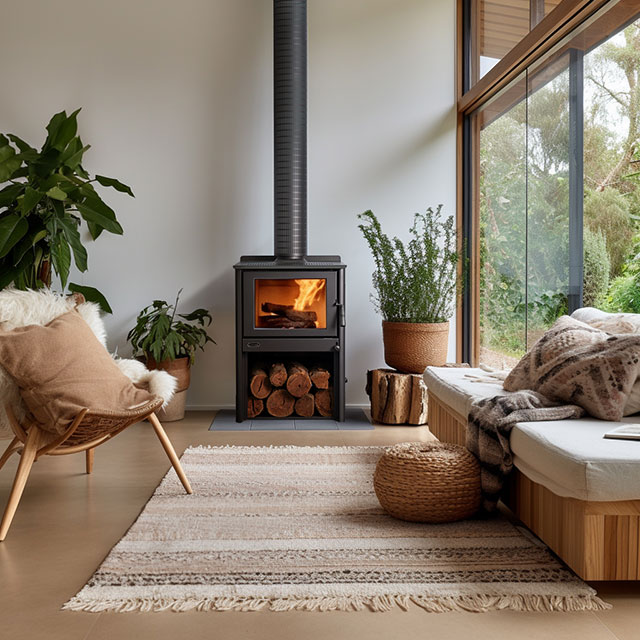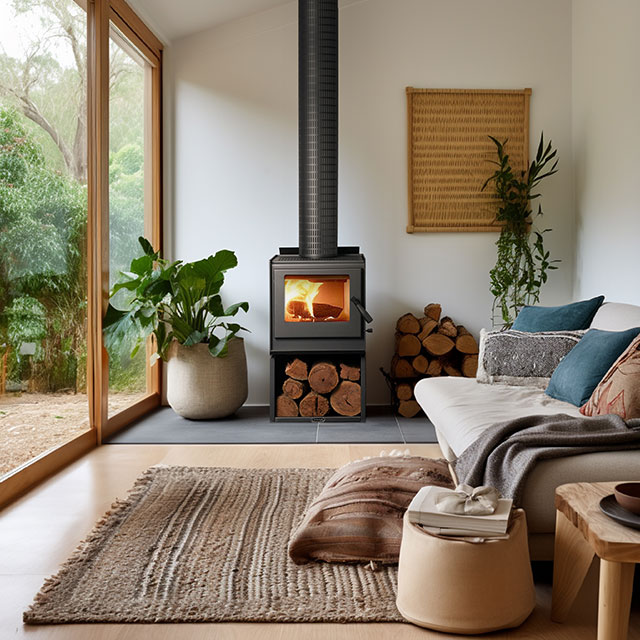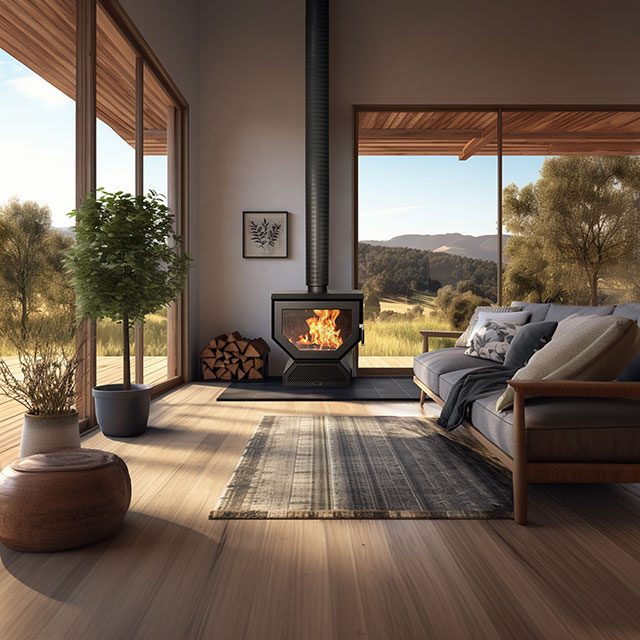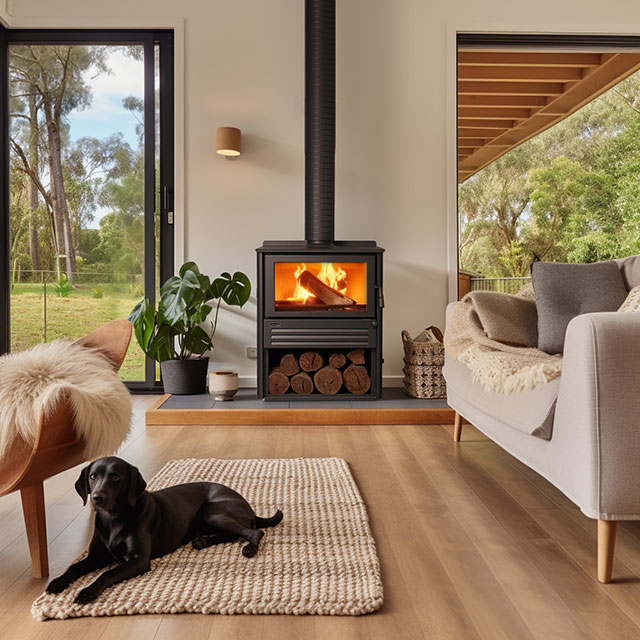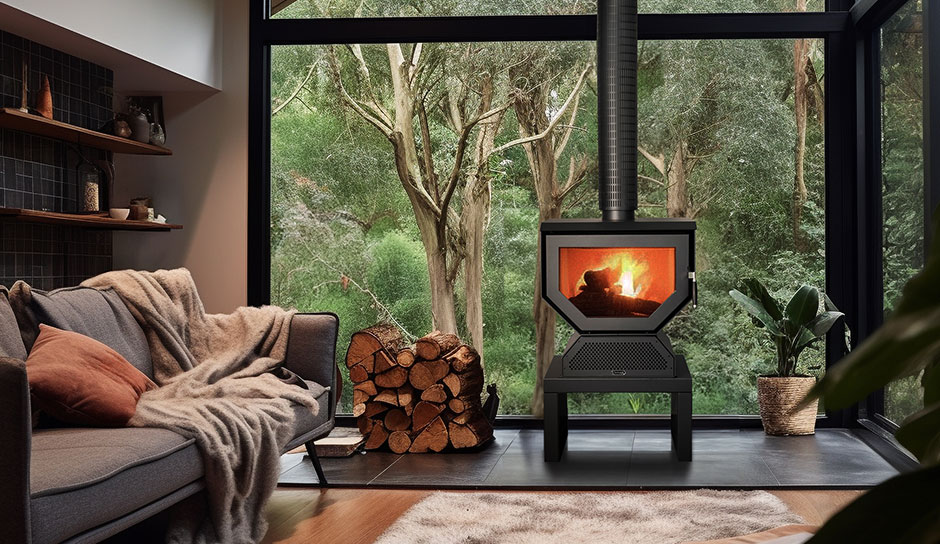When it comes to enjoying a cosy evening by the fireplace, the type of wood you choose can make all the difference. Not only does the right firewood ensure a longer, cleaner burn, but it also minimises potential hazards. Dive into this comprehensive guide to discover the best and worst types of wood for your fireplace and why making the right choice is essential for efficiency and safety.
Why Does the Type of Wood Matter?
Choosing the right type of wood for your fireplace is crucial for several reasons. The right firewood burns efficiently, producing the maximum amount of heat with minimal smoke. This not only ensures a comfortable environment but also reduces the risk of chimney fires.

Hardwood vs. Softwood: Which is the best wood to burn?
The quality and enjoyment of fireplaces and wood burners for conditions in Australia is significantly determined by the type of wood you choose. While hardwoods are dense and burn slowly, providing a lasting warmth, softwoods ignite quickly and produce more smoke and resin, making them less than perfect fires, and they tend to burn out faster. For an optimal fire, it can sometimes be a strategy to initiate with softwood kindling if that is all there is available and then add hardwood logs to maintain the burn. But, burning any kind or amount of softwood means that you should ensure that your flue or chimney is regularly inspected for creosote buildup. We recommend that only hardwoods are burned in your wood burning fireplace.
Hardwoods to Consider: The Best Type of Wood to Burn
When it comes to selecting the ideal wood to burn in a fireplace, Australian hardwoods often stand out as the top contenders. Their dense nature and slow-burning characteristics make them one of the best types of firewood. In Australia, the choice of wood varies depending on the region due to availability. Here's a breakdown of the best hardwoods to use in different states:
Jarrah and Wandoo: Best for Western Australia
- Longevity: Both Jarrah and Wandoo are known for their extended burn time, reducing the frequency of restocking on chilly evenings.
- Heat Output: These woods produce a consistent and high heat output, making them top choices for fireplaces in Western Australia.
- Minimal Smoke: When seasoned, both Jarrah and Wandoo emit minimal smoke, ensuring a cleaner and more efficient burn.
Brown Peppermint: Top Choice in Tasmania
- Easy Ignition: Brown Peppermint is recognised for its easy ignition properties, making it the primary choice in Tasmania.
- Versatility: While it burns hotter and faster than Jarrah, it's still a preferred wood for both brief and prolonged fireplace sessions in Tasmania.
- Pleasant Aroma: An added advantage of burning Brown Peppermint is the delightful scent it releases, elevating the overall fireplace ambience.
River Red Gum: Preferred in South Australia, Victoria, and Southern NSW
- Consistent Burn: River Red Gum offers a steady burn, ensuring warmth for extended periods.
- Heat Efficiency: This wood type burns intensely hot, ensuring spaces remain warm and inviting.
- Low Creosote Production: When seasoned appropriately, River Red Gum produces minimal creosote, ensuring a safer burn and less frequent chimney maintenance.
Ironbark and Box: Favourites in Queensland
- These woods are dense and provide a long-lasting burn, making them the top choices for Queenslanders looking for warmth and efficiency.
Choosing the best firewood for your wood heater or fireplace is crucial for both efficiency and safety. It's essential to ensure that the wood is seasoned before burning and stored correctly. This not only guarantees a better burn but also prolongs the life of your fireplace and chimney. And remember, when in doubt, always consult with experts like your local Coonara Dealer to make the best choice for your wood-burning needs.
Best Types of Softwoods To Burn In Your Fireplace
While hardwoods are often favoured for their long burn time, softwoods have their advantages for those who have no other options. Pine and cedar, for instance, set fire easily and produce a fragrant aroma. However, they burn faster and leave behind more smoke and creosote, so it’s best to use them in moderation. For open fireplaces, a larger chimney sometimes means more room for smoke to exhaust, but a smaller diameter in a wood burner flue creates a compressed space where creosote and resins from softwoods can build up quickly, creating a fire risk. It is advised to avoid softwoods in most situations.
The Importance of Seasoned Dry Wood in Your Fireplace
The best firewood is seasoned wood which is dry wood. It has been left to dry out, reducing its moisture content. Burning this type of wood ensures a hotter, cleaner, and more efficient fire. Wet or green wood produces more smoke and can lead to more creosote buildup in your chimney.
The Worst Types of Wood for Burning
While the allure of a roaring fire is undeniable, it's crucial to ensure that the wood you're burning is not only efficient but also safe. Some woods might seem like a good choice at first glance, but they can lead to problems down the line. Here's a closer look at the culprits:
Wet or Unseasoned Wood:
- Smoke Galore: Wet wood is notorious for producing a lot of smoke. This not only makes for an unpleasant experience but can also lead to respiratory issues if you're exposed for extended periods.
- Creosote Buildup: Burning unseasoned wood can lead to an increase in this sticky substance which is a fire hazard and can lead to chimney and flue fires if not addressed.
Woods High in Sap and Resin:
- Pine and Cedar: While these woods burn quickly and have a delightful aroma, they can produce a significant amount of creosote. It's best to use them sparingly and ensure your flue or chimney is cleaned regularly.
- Difficult to Ignite: Some woods, especially those high in moisture content, can be challenging to ignite. This can lead to frustration and an inefficient fire.
Softwoods with High Moisture Content:
- Burns Too Fast: Some softwoods, even when seasoned, can burn too quickly, making them inefficient for heating purposes.
- Excessive Smoke: These woods can produce excessive smoke and leave behind a lot of ash, making cleanup a chore.
Treated or Painted Wood:
- Release of Harmful Chemicals: Burning wood that has been treated or painted can release harmful chemicals into the air. This is not only bad for the environment but can also pose health risks.
While it might be tempting to use any wood to burn in your wood heater, it's essential to be selective. Choosing the right wood ensures that your fire is not only efficient but also safe for both your home and the environment. And if you're ever in doubt, it's always a good idea to contact experts like your Coonara retailer for guidance.
The Role of Moisture Content in Firewood: Understand What Kind of Wood to Burn
Understanding the moisture content in firewood is essential for anyone looking to enjoy a warm, efficient fire in their fireplace. The amount of moisture in the wood directly impacts its burning characteristics and overall performance. Dry firewood, characterised by its low moisture content, is the ideal choice for several reasons.
Firstly, dry wood burns hotter. The absence of excess moisture means the energy from the fire isn't wasted on evaporating water but is instead directed towards producing heat. This results in a more intense flame that can warm your living space more effectively.
On the other hand, wet or unseasoned wood, with its high moisture content, presents several challenges. As mentioned, this firewood produces more smoke, which can lead to an unpleasant ambience and potential respiratory issues for those in the vicinity. Additionally, wet wood is notoriously difficult to ignite. The energy that could be used to produce heat is instead consumed in trying to evaporate the water content, leading to a less efficient fire.

The Importance of Chimney Maintenance
Creosote, a dark and sticky substance, is an inevitable by-product of burning wood. While all types of wood produce some amount of creosote, softwoods and wet, unseasoned wood are particularly notorious for their higher creosote output. This substance can adhere to the walls of your chimney, gradually building up over time. If left unchecked, this accumulation can pose a significant fire hazard, leading to dangerous chimney fires that can cause extensive damage to your home and even risk lives.
The primary reason behind this formation is incomplete combustion. When wood doesn't burn completely, it releases certain compounds in the form of smoke. As this smoke rises and cools down in the chimney, it condenses, forming creosote. Wet wood, due to its high moisture content, doesn't burn as efficiently as dry wood, leading to more smoke and, consequently, more residue.
Regular chimney inspections and cleanings are crucial. An annual inspection by a professional can help identify any potential issues. Depending on how frequently you use your fireplace and the type of wood you burn, you might need chimney cleanings more often.
Choosing the best wood for your fireplace also plays a pivotal role in minimising creosote formation. As mentioned, dry, seasoned wood burns more efficiently, producing less smoke. It's also advisable to avoid burning treated or painted wood, as burning this type of wood can release additional chemicals that contribute to creosote buildup.
While enjoying the warmth and ambience of a wood-burning fireplace is a delightful experience, it comes with the responsibility of ensuring safety. By being mindful of the different types of wood you burn and staying diligent with chimney maintenance, you can enjoy countless cosy evenings by the fire without the looming threat of creosote-related hazards. If ever in doubt, seeking advice from chimney care professionals is always a wise decision.
Wood Storage: Stacking Your Wood
The process of enjoying a warm, crackling fire doesn't start when you place the wood in the fireplace; it begins much earlier, with the proper storage and stacking of your firewood. Ensuring your wood remains dry and free from moisture is paramount to achieving an efficient and clean burn. Let's delve into the best practices for storing your firewood to ensure it's always ready to ignite.
Firstly, the location of your wood storage matters immensely. While it might be tempting to stack your firewood directly on the ground, this can expose it to moisture from the soil, leading to damp wood that's difficult to burn. Instead, consider elevating your wood stack slightly off the ground using pallets or a custom-built wood rack. This not only prevents moisture absorption from the ground but also ensures better air circulation, aiding in the drying process.
The design of your wood stack can also influence its drying efficiency. While there's an art to stacking firewood, the primary goal is to ensure maximum airflow. A well-ventilated stack will dry faster and more evenly. Consider leaving some gaps between logs and stacking them in a crisscross pattern to promote better air circulation.
Protection from the elements is another crucial aspect of firewood storage. While it's essential for wood to be exposed to air, it should be shielded from direct rainfall. A simple solution is to cover the top of your wood stack with a tarp or dedicated wood cover. However, avoid wrapping the entire stack, as this can trap moisture and hinder the drying process.
Lastly, consider the duration for which you store your wood. Seasoned wood, which has been dried for at least six months, burns more efficiently. If you're sourcing your firewood, it's a good idea to plan ahead and allow ample time for seasoning before it's needed for burning.
In conclusion, while sourcing the right type of wood is essential, how you store it plays an equally vital role in your wood-burning experience. Proper storage ensures that when the cold days arrive, your firewood is dry, seasoned, and ready to provide warmth and comfort to your home. Remember, the key lies in keeping it dry, well-ventilated, and protected from excessive moisture.
Coonara: The Experts in Wood Burning
Coonara boasts an exceptional range of wood heaters, meticulously designed to bring both warmth and a homely charm to your interiors. With a diverse spectrum of sizes, aesthetics, and models at your disposal, finding a Coonara wood heater tailored to both your home's specifications and your personal preferences becomes an effortless endeavour. With dealers located throughout Australia, you’re sure to find a Coonara near you.
